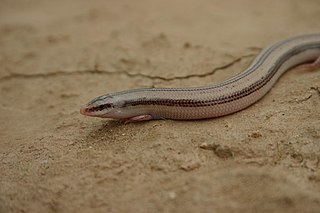
The Florida sand skink is a species of lizard in the family Scincidae, the skinks. It is endemic to Florida in the United States.

Ophiomorus is a genus of Old World skinks. The limbs are either reduced or absent, depending on the species. They are sometimes known as limbless skinks or snake skinks. Members of the genus live under rocks or in underground burrows.

Phrynocephalus theobaldi is a species of lizard in the family Agamidae. The species is endemic to Asia.
Ophiomorus tridactylus, commonly known as the three-toed snake skink, is a species of skink endemic to sandy desert areas of South Asia. It is also called the Indian sand-swimmer for its habit of moving just under the sand.

Sphenomorphus dussumieri, commonly known as Dussumier's forest skink, is a species of skink, a lizard in the family Scincidae. The species is endemic to southern India.
The eastern skink, also commonly known as the Arabian sand skink and the eastern sand fish, is a species of lizard in the skink family (Scincidae).
Anomalopus mackayi, commonly known as the five-clawed worm skink, long-legged worm skink, and MacKay's burrowing skink, is a species of smooth-scaled burrowing skink, a lizard in the family Scincidae. The species is endemic to eastern Australia.

Latast's snake skink is a species of skink, a lizard in the family Scincidae. The species is endemic to the Near East.

The Greek snake skink is a species of skink, a lizard in the family Scincidae.

Gardiner's burrowing skink is a species of lizard in the family Scincidae. P. gardineri is the only species in the (monotypic) skink genus Pamelaescincus.
The Satinay sand skink or Fraser Island sand skink is a species of skink, a lizard in the family Scincidae.
Anomalopus swansoni, also known commonly as the punctate worm-skink or Swanson's burrowing skink, is a species of lizard in the family Scincidae. The species is endemic to Australia.
Papuascincus stanleyanus is a species of skink, a lizard in the family Scincidae. The species is endemic to New Guinea.

Pseudemoia baudini, also known commonly as Baudin's skink, Baudin's window-eyed skink, and the Bight Coast skink, is a species of lizard in the family Scincidae. The species is endemic to Australia.
Kaestlea beddomii, also known commonly as Beddome's ground skink, is a species of lizard in the family Scincidae. The species is endemic to the Western Ghats of India.
Lerista storri, also known commonly as the Mount Surprise slider or Storr's lerista, is a species of lizard in the family Scincidae. The species is endemic to Australia.
Ophiomorus blanfordii, also known commonly as Blanford's snake skink, is a species of lizard in the family Scincidae. The species is native to Western Asia and South Asia.
Chernov's snake skink is a species of skink, a lizard in the family Scincidae. The species is from Turkmenistan and Iran.

Ophiomorus nuchalis, the Nilson's snake skink or plateau snake skink, is a species of skink, a lizard in the family Scincidae. The species is endemic to Iran.

Street's snake skink is a species of skink, a lizard in the family Scincidae. The species is from Iran.










